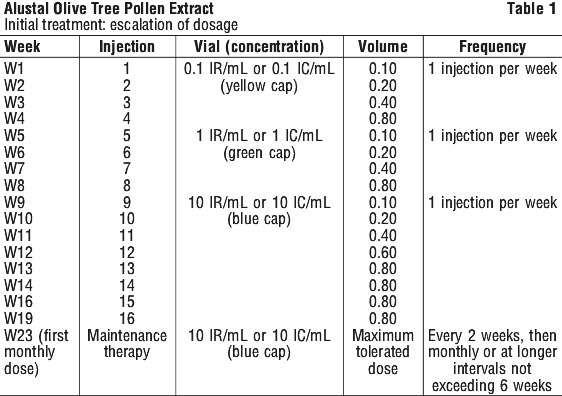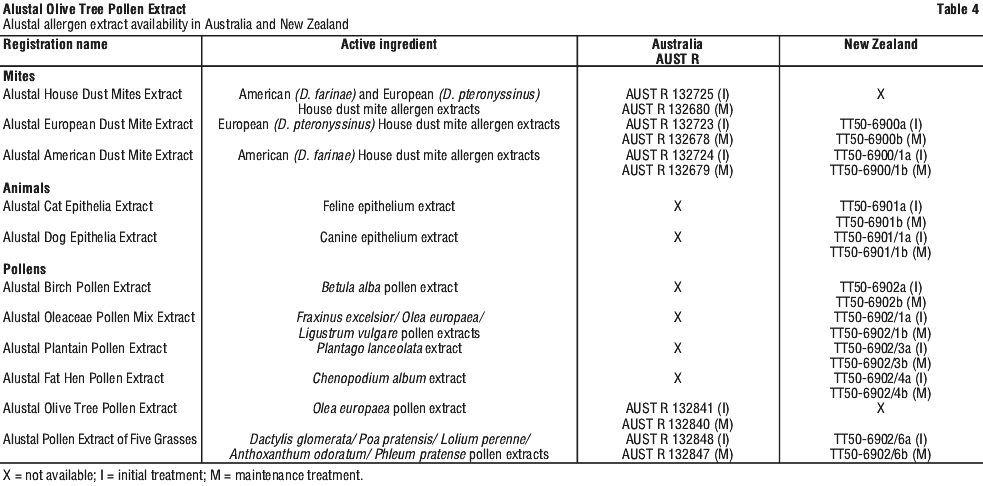What is in this leaflet
This leaflet answers some common questions about Alustal allergen extracts.
It does not contain all of the available information. It does not take the place of talking to your doctor or pharmacist.
All medicines have risks and benefits. Your doctor has weighed the risks of giving you Alustal allergen extracts against the expected benefits it will have for you.
If you have any concerns about being given this medicine, ask your doctor or pharmacist.
What Alustal is used for
Alustal belongs to a group of medicines called anti-allergy preparations and is used in the treatment of seasonal or perennial rhinitis, conjunctivitis and rhino-conjunctivitis with or without associated asthma.
Alustal is given as a subcutaneous treatment and this is often referred to as SIT (Subcutaneous Immunotherapy Treatment)
How it works:
A list of allergen available in Australia and New Zealand is provided at the end of this leaflet. The exact type will depend on your allergy and what your doctor identifies as the cause of your allergy. The aim of treatment with allergen extracts is to prevent the more severe allergic reactions you experience.
Alustal works by slowly increasing your tolerance to specific allergens and decreases the severity of your allergic reactions.
The injection is specifically designed according to individual patient needs. Alustal helps to increase your tolerance to allergens and may decrease the severity of your allergic reactions.
Ask your doctor if you have any questions why Alustal has been prescribed for you.
Alustal is not addictive. This medicine is available only with a doctor’s prescription and administered under a doctor’s supervision.
Before you are given Alustal
When you must not be given Alustal
Do not start Alustal treatment if:
- You have unstable asthma, severe immunodeficiency, malignant disease, or autoimmune disease. Injection should be avoided if you have bleeding tendency.
- You are currently receiving treatment with beta-blockers (often in medicines for blood pressure or heart conditions), as you may be unresponsive to the usual doses of adrenaline used to treat anaphylactic reactions.
- You have problems with your kidneys - renal insufficiency - as this may increase the risk of accumulation of aluminium from aluminium hydroxide preparations (as for any aluminium hydroxide vaccine) into tissues (central nervous system, bones)
- The package shows signs of tampering.
- The expiry date (EXP) printed on the pack has passed.
If you receive injections of this medicine after the expiry date has passed, it may not work as well.
It is not advisable to use SIT during pregnancy: pregnancy is not considered as a contraindication to the continuation of immunotherapy but treatment should not be started during pregnancy. If a patient becomes pregnant during initial treatment, stop injections; if a patient becomes pregnant during maintenance therapy, treatment may continue if well tolerated.
There is no data available on the excretion of allergen extracts in human milk or any effect on breast-fed infants.
If you are not sure if you should be taking Alustal, talk to your doctor
Before you start your treatment with Alustal:
Tell your doctor if:
You have any other health problems, especially the following:
- Asthma or other respiratory problems.
- You have, or have previously had, a serious immunological disease.
- You have a bleeding tendency.
- You have an autoimmune disease. Your doctor will decide if the risk from allergen exposure is greater than the risk of exacerbating the autoimmune disease.
- You have acute fever, uncontrolled allergic symptoms and recent exacerbation of asthma. Your doctor can decide to delay treatment.
If you have not told your doctor about any of the above, tell him/her before you start treatment with Alustal
Taking other medicines
- Tell your doctor if you are taking any other medicines, including any that you have bought from a pharmacy, supermarket or health food shop.
- Some medicines may interfere with Alustal. These medicines include:
Beta-blockers (blood pressure or heart medications), including topically administered beta-blockers, are known interfere with treatment of anaphylactic reactions. They may make you less responsive to the usual doses of epinephrine (adrenaline) used to treat anaphylactic reactions.
Your doctor will advise you.
Your doctor or pharmacist has more information on medicines to be careful with or avoid while taking any of the Alustal.
Ask your doctor or pharmacist if you are not sure if your medicine is one of the ones listed above.
How Alustal is given
How much is given
Your treatment schedule will include:
Initial treatment and maintenance treatment:
Your doctor will tell you how much medicine will be given during each treatment.
- Normally initial treatment will be weekly injections lasting for approximately 14 weeks. This will be of the allergen that you are allergic to in increasing concentrations up to the highest dose you can tolerate.
- Maintenance treatment will be of monthly injections of the highest concentration that you can tolerate comfortably.
Where two different courses are being given concurrently, the two extracts must never be mixed within the same syringe. Injections of the two extracts may be given at the same visit, but in separate arms. However mixtures of allergens may have been prescribed for you by your Doctor, these will already be mixed and given in a single injection. But the doctor may need to give more than one injection if you are being treated for more than one allergy.
How Alustal is given
Alustal is given as an injection under the skin (subcutaneously) It is not injected into a blood vessel or intramuscularly.
How long to have it Alustal for
Treatment or maintenance should continue for 3 to 5 years depending on the severity of the allergy and response to treatment.
If you miss a dose:
If you miss a dose, talk to your doctor and arrange another visit as soon as possible.
If you are given too much (overdose)
Overdose is unlikely because your doctor will give you this medicine by injection. If you think that you may have been given too much Alustal, immediately tell your doctor or go to Accident and Emergency at your nearest hospital. Symptoms such as:
- generalized rash,
- itching,
- swelling of lips, face, tongue or other parts of the body,
- shortness of breath, respiratory or cardiac distress (including asthma),
- seizures,
may occur. If you have any concerns, ask your doctor.
While you are receiving Alustal
Things you must do
Tell all doctors, dentists and pharmacists who are treating you, that you are receiving Alustal.
Tell your doctor if you feel the treatment is not helping your condition.
Keep all of your appointments with your doctor so that your progress can be checked. It is important to have your follow-up doses of Alustal at the appropriate times to make sure the immunotherapy has the best chance of working.
Things you must not do
It is recommended to avoid any activity that may increase blood flow through the injection site such as strenuous exercise, hot baths, sauna, application of local heat or rubbing, for the remainder of the day.
Things to be careful of
- You must avoid strenuous activity for the remainder of the day
- You must wait in the doctor’s waiting room for at least 30 minutes following your Alustal injection. The majority of serious reactions will begin within 30 minutes after an injection. Patients should be instructed to seek medical advice immediately if symptoms develop after leaving the clinic. The more rapidly symptoms begin, the more severe they are likely to be and the more rapidly treatment measures should begin.
- Alustal is presumed to be unlikely to produce an effect on the ability to drive or use machinery.
Side effects
Alustal allergen extracts helps most people with allergies but they may have unwanted side effects in a few people.
All medicines can have side effects. Sometimes they are serious, most of the time they are not. You may need medical treatment if you get some of these side effects.
Contact your doctor or nurse immediately if symptoms of an allergic reaction occur.
Tell your doctor or pharmacist as soon as possible if you do not feel well while you are receiving Alustal.
Tell your doctor immediately if you notice any of the following and they worry you:

Of these, the more serious effects can include
- generalized rash,
- itching,
- swelling of lips, face, tongue or other parts of the body,
- shortness of breath or tightness (including asthma)
- seizures
Tell your doctor immediately or go to Accident and Emergency at your nearest hospital if you notice any of the above:
Serious side effects are rare. This is not a complete list of all possible side effects. Others may occur in some people and there may be some side effects not yet known.
Tell your doctor if you notice anything else that is making you feel unwell, even if it is not on this list.
Ask your doctor or pharmacist to answer any questions you may have and to explain anything you do not understand on this list.
Do not be alarmed by this list of possible side effects. You may not experience any of them.
After using Alustal
Storage
Alustal is usually stored in the doctor’s surgery. However, if you need to store it:
- Keep it where children cannot reach it
- Keep it in the original pack
- Keep it in the refrigerator (between 2° to 8°C). Do not freeze.
Disposal
Your doctor will dispose of any unfinished medicine if the vials have passed their expiry date.
Product description
What Alustal looks like
Each 5mL vial contains specific allergen extract(s) in suspension and are available in various concentrations for many different allergens. Your Doctor will choose the correct allergen to treat your allergy. Other ingredients in all allergen suspensions include aluminium hydroxide hydrate, sodium chloride, phenol, mannitol and water for injections.
Alustal presentation
Initial treatment set: 3 vials, each vial containing either 0.1, 1.0 and 10.0 IR/mL or IC/mL.
Maintenance set: a single vial containing 10.0 IR/mL or IC/mL.
Available Concentrations:
Vial containing 5 mL of suspension.
Yellow cap: 0.1 IR/mL or 0.1 IC/mL
Green cap: 1.0 IR/mL or 1.0 IC/mL
Blue cap: 10.0 IR/mL or 10.0 IC/mL
(IR/mL is the Index of Reactivity per mL)
(IC/mL is the Index of Concentration per mL)
Ingredients
Alustal products contain either a single allergen extract or a combination of allergen extracts within the mite or pollen group of allergens.
ALUSTAL is prepared from freeze-dried allergen extracts adsorbed onto aluminium hydroxide gel. The freeze-dried allergen extracts are prepared by ammonium bicarbonate extraction of the allergen source materials e.g. pollen, mites. Specific allergen(s) are selected by the physician for Specific Immunotherapy Treatment (SIT) for the individual patient.
Sponsor
NAME AND ADDRESS OF THE SPONSOR
Sponsor in Australia:
Stallergenes Australia Pty Ltd
Suite 2408
4 Daydream St.,
Warriewood, NSW 2102
Ph: 1800 824 166
Sponsor in New Zealand:
Stallergenes Greer New Zealand Limited
Level 1, 24 Manukau Road,
Epsom, Auckland 1023
New Zealand
Ph: 0800 824 166
Date of preparation:
16 June 2021



Published by MIMS February 2022



 As with all forms of hyposensitisation therapy, local and/or systemic reactions may occur. Injections of Alustal may be associated with some itching and redness at the injection site. Prolonged pain or pain radiating up the arm is usually the result of intramuscular injection. The tolerated dose is not necessarily constant, but may vary over time, depending on the individual's specific reactivity and environment.
As with all forms of hyposensitisation therapy, local and/or systemic reactions may occur. Injections of Alustal may be associated with some itching and redness at the injection site. Prolonged pain or pain radiating up the arm is usually the result of intramuscular injection. The tolerated dose is not necessarily constant, but may vary over time, depending on the individual's specific reactivity and environment.
